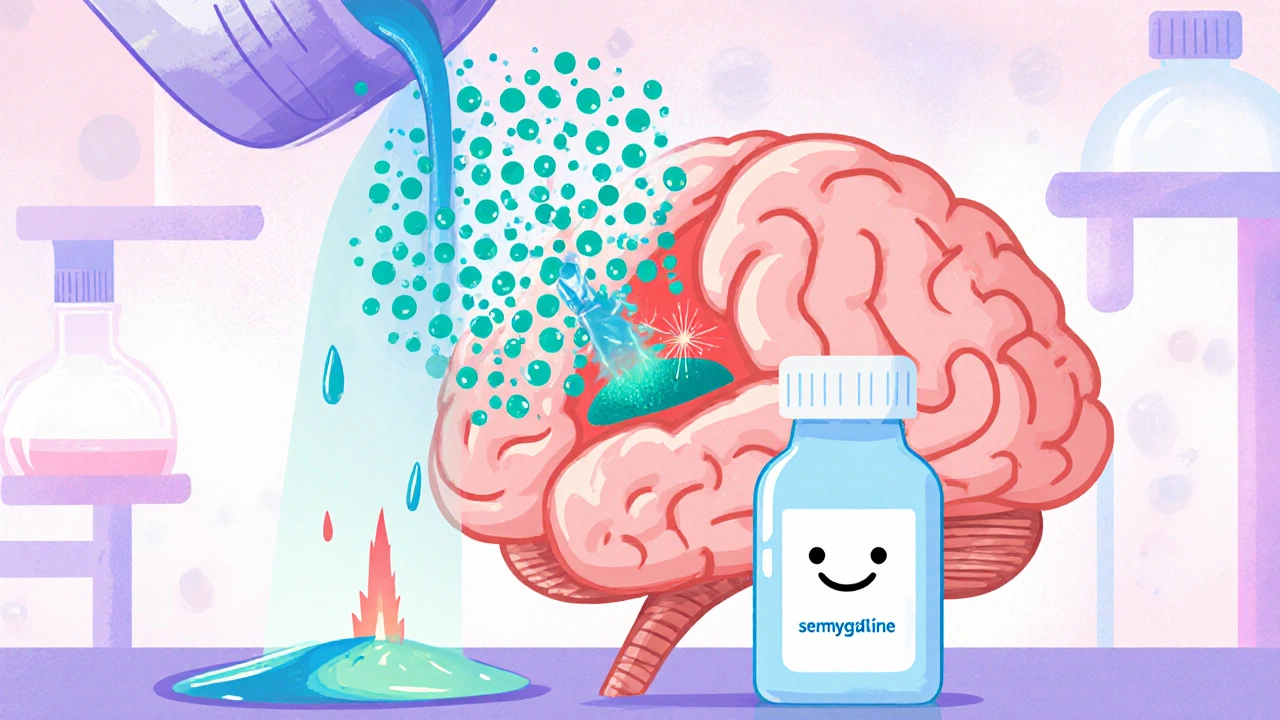Sertraline Dosage Calculator
How This Calculator Works
This tool helps you determine the appropriate sertraline dosage for panic disorder based on your current treatment stage and side effect profile. The calculator follows FDA guidelines and clinical evidence for optimal titration.
Next Recommended Dose
Therapeutic Range 100-200 mg daily for panic disorder
What to Expect
Imagine a sudden wave of terror that hits you out of nowhere, making your heart race and your thoughts scramble. That’s what living with panic disorder feels like-an unpredictable roller‑coaster of fear that hijacks everyday life. If you’ve tried breathing tricks, therapy, or lifestyle tweaks without lasting relief, you’ve probably wondered whether a medication could smooth the ride. Sertraline is a selective serotonin reuptake inhibitor (SSRI) approved for panic disorder, and it can be the steady anchor many people need to reclaim calm.
What Exactly Is Panic Disorder?
Panic Disorder is a mental health condition characterized by recurrent, unexpected panic attacks-intense surges of fear that peak within minutes. Symptoms include rapid heartbeat, sweating, trembling, shortness of breath, and a lingering fear of future attacks. The disorder isn’t just a bout of nerves; it can drive avoidance behaviors, limit work performance, and strain relationships.
According to the FDA, about 2-3 % of adults in the United States will experience panic disorder at some point, making it one of the more common anxiety disorders. While therapy can teach coping skills, many clinicians recommend medication to lower the physiological surge that fuels the attacks.
Sertraline: A Quick Overview
Sertraline belongs to the class of drugs known as Selective Serotonin Reuptake Inhibitors (SSRIs). By blocking the reabsorption of serotonin in the brain, it increases the neurotransmitter’s availability, helping to stabilize mood and dampen the overactive fear circuitry that triggers panic attacks.
First approved by the FDA in 1991 for depression, sertraline received an additional indication for panic disorder in 1996. Since then, hundreds of clinical trials have confirmed its efficacy, making it one of the most prescribed SSRIs for anxiety.
How Sertraline Calms the Fear Response
The brain’s fear center-primarily the amygdala-reacts to perceived threats by releasing a cascade of chemicals, including serotonin. In panic‑prone individuals, this system is hypersensitive, so a minor trigger can launch a full‑blown attack.
Sertraline’s steady increase in serotonin levels helps re‑balance this circuit. Researchers at the University of Pennsylvania found that after eight weeks of sertraline treatment, participants showed a 34 % reduction in amygdala hyperactivity during stress tasks, directly correlating with fewer panic episodes.
In plain terms, the drug doesn’t stop panic from happening entirely, but it raises the threshold at which the brain decides to sound the alarm, giving you more breathing room to use coping strategies.
Clinical Evidence: What the Studies Say
- Study A (2002, double‑blind, 300 participants): 58 % of patients on sertraline reported at least a 50 % reduction in panic‑attack frequency versus 22 % on placebo.
- Study B (2018, meta‑analysis of 12 RCTs): SSRIs, with sertraline leading, produced an average effect size of 0.78 for panic‑disorder symptom severity-a strong, clinically meaningful improvement.
- Real‑world data (2023, electronic health records): Patients initiating sertraline had a 41 % lower risk of emergency‑room visits for panic attacks compared to those on non‑SSRI anxiolytics.
These numbers reinforce why guidelines from the American Psychiatric Association (APA) list sertraline as a first‑line pharmacologic option for panic disorder.

Starting Sertraline: Dosage & Titration
Getting the dose right is a balancing act between efficacy and tolerability. Here’s a practical roadmap:
- Initial dose: 25 mg daily for the first week. This low “starter” helps your body adjust to the serotonin boost.
- First increase: Raise to 50 mg daily on day 8, provided you’re not experiencing severe side effects.
- Therapeutic range: 100-200 mg daily is typical for panic disorder. Most studies report optimal response around 150 mg.
- Maximum dose: 200 mg per day; higher doses rarely add benefit but increase risk of side effects.
- Titration speed: If you’re sensitive to side effects, extend each dose level by one week before moving up.
Always take sertraline in the morning with food to minimize nausea. If you miss a dose, take it as soon as you remember-unless it’s close to the next scheduled dose, then skip the missed one.
Managing Common Side Effects
Like any medication, sertraline comes with a side‑effect profile. Most issues are mild and fade within two weeks, but it helps to know what to expect and how to ease them.
| Side Effect | Typical Onset | Suggested Management |
|---|---|---|
| Nausea | Days 1-3 | Take with meals; ginger tea can help |
| Insomnia | First 1-2 weeks | Switch to morning dosing; avoid caffeine after noon |
| Sexual dysfunction | Weeks 2-4 | Discuss dose adjustment or “drug holiday” with your doctor |
| Dizziness | First week | Rise slowly from sitting/lying; stay hydrated |
| Weight changes | Month 2+ | Monitor diet; regular exercise |
If you notice any severe reactions-such as rash, swelling, or thoughts of self‑harm-seek medical attention immediately. Rarely, SSRIs can trigger serotonin syndrome, especially if combined with other serotonergic drugs.
Sertraline vs. Other SSRIs for Panic Disorder
| Medication | Typical Starting Dose | FDA Panic‑Disorder Approval | Common Side Effects |
|---|---|---|---|
| Sertraline | 25 mg daily | Yes (1996) | Nausea, insomnia, sexual dysfunction |
| Paroxetine | 10 mg daily | Yes (1992) | Weight gain, fatigue, withdrawal risk |
| Fluoxetine | 10 mg daily | Off‑label | Insomnia, agitation, appetite loss |
Sertraline often wins out for panic disorder because it balances efficacy with a relatively lower risk of weight gain and withdrawal symptoms compared to paroxetine.

Combining Medication with Therapy
Medication addresses the biological side of panic, but pairing it with Cognitive Behavioral Therapy (CBT) yields the best outcomes. CBT teaches you to reframe catastrophic thoughts and practice exposure drills, so when sertraline lowers the physiological spike, your mind is also learning healthier patterns.
Studies show that combined treatment reduces panic‑attack frequency by up to 70 % versus medication alone. If you’re new to therapy, ask your psychiatrist for a referral to a licensed CBT practitioner experienced with anxiety disorders.
What to Expect: Timeline of Effects
- Week 1-2: You may feel mild side effects; panic attacks might still occur.
- Weeks 3-4: Many patients notice a 20-30 % drop in attack frequency as the serotonin system steadies.
- Weeks 6-8: Full therapeutic effect often emerges-up to 50 % reduction or more.
- Beyond 3 months: Continue regular check‑ins with your prescriber; dosage tweaks may be needed based on symptom control and side‑effect tolerance.
Patience is key. If you don’t see improvement after eight weeks at a therapeutic dose, discuss alternative options with your doctor-sometimes switching to another SSRI or adding an adjunct like an atypical antipsychotic can help.
Frequently Asked Questions
Can I take sertraline if I’m pregnant?
Sertraline is categorized as Pregnancy Category C. This means risk cannot be ruled out, but studies have not shown a clear increase in birth defects. Your obstetrician and psychiatrist should weigh the benefits of anxiety control against any potential risks.
How long should I stay on sertraline?
Most clinicians recommend a minimum of 6-12 months of continuous treatment after panic symptoms are under control. Long‑term use is common and safe for many patients, but periodic evaluation is essential.
Will sertraline make me feel numb or less emotional?
A mild “blunting” of emotional intensity can happen, especially at higher doses. If you notice this, discuss dose reduction or a medication switch with your prescriber.
Can I stop sertraline abruptly?
No. Abrupt cessation can trigger discontinuation syndrome-symptoms include dizziness, electric‑shock sensations, and anxiety spikes. taper the dose slowly under medical supervision.
Is sertraline safe to combine with alcohol?
Mixing alcohol with sertraline can worsen drowsiness, impair judgment, and increase anxiety after the alcohol wears off. Limit intake and discuss any drinking habits with your doctor.
Next Steps: Getting Started Safely
If you think sertraline could be the missing piece in your panic‑disorder toolkit, here’s a simple action plan:
- Schedule a visit with a psychiatrist or a primary‑care doctor experienced in anxiety disorders.
- Bring a symptom diary-note the frequency, triggers, and intensity of your panic attacks.
- Ask about a low‑dose start (25 mg) and a clear titration schedule.
- Discuss whether adding CBT would be feasible for you.
- Set a follow‑up appointment in 4-6 weeks to assess response and side effects.
Remember, medication is just one part of a broader recovery plan. With the right dosage, supportive therapy, and a bit of patience, many people regain control over their lives and say goodbye to the constant fear that once dictated their days.


Oh wow, you actually read the whole sertraline primer-now go grab that 25 mg starter like a superhero on a coffee break.
Dearest reader, your curiosity about the pharmacological nuances is simply admirable; I trust this exposition shall elevate your understanding to a most refined plateau.
Ah, the hero’s journey begins with a tiny pill, but remember, dear seeker, that the mind’s labyrinth is not solved by dosage alone 😉😊
🌍 Let’s celebrate the fact that knowledge knows no borders; whatever your background, sertraline can be a bridge to calmer days, and we’re all cheering you on! 🌈
Picture this: your panic attacks are like wild fireworks, and sertraline is the calm night sky that tames the sparkle-bright, bold, and beautifully controlled.
Sertraline works by inhibiting the reuptake of serotonin, which gradually raises the neurotransmitter’s availability in synaptic clefts. This increase helps to stabilize the limbic circuitry that governs fear and anxiety. Most clinicians start patients on a 25 mg dose for the first week to gauge tolerability. After about a week, if side effects are mild, the dose is usually increased to 50 mg daily. Therapeutic effects for panic disorder often emerge between four and eight weeks of consistent dosing. The optimal range for many adults lies between 100 and 150 mg, though some may require up to 200 mg for full symptom control. It is crucial to monitor blood pressure and heart rate during titration, especially in patients with cardiovascular comorbidities. Common early side effects include nausea, insomnia, and mild dizziness, which typically subside within two weeks. If nausea persists, taking the medication with food or a light snack can help mitigate discomfort. For insomnia, consider switching the dose to the morning or reducing caffeine intake after midday. Sexual dysfunction may appear after a few weeks; discuss dose adjustments or drug holidays with your prescriber if this becomes problematic. Should you experience any signs of serotonin syndrome-such as agitation, hyperthermia, or clonus-seek emergency medical attention immediately. In rare cases, patients report a flattening of affect; if emotional blunting interferes with daily life, a dosage reduction might be warranted. Regular follow‑up appointments every four to six weeks allow the clinician to assess efficacy and adjust the regimen accordingly. Adjunctive cognitive‑behavioral therapy has been shown to boost response rates significantly, so consider integrating psychotherapy into your treatment plan. Finally, never discontinue sertraline abruptly; a gradual taper over several weeks minimizes withdrawal symptoms and reduces relapse risk.
Honestly, putting faith in a cheap pill while ignoring lifestyle factors is a lazy shortcut; you’re better off confronting the root triggers head‑on rather than numbing yourself.
Wow, thanks for the groundbreaking insight-because clearly ignoring decades of research in favor of “head‑on” bravery is the sensible path for everyone.
Sertraline can help, but it’s not a magic bullet.
What they don’t tell you is that the pharma industry designs these “magic bullets” to keep us dependent, while the real solution lies in uncovering the hidden neuro‑feedback loops they suppress.
Oh, please, you’ve cracked the code? The only secret is that proper dosing and therapy actually work, not some nebulous “hidden loops” you read about on obscure forums.
Life is like a sertraline capsule-sometimes you swallow the whole truth, other times you just feel the bitter aftertaste of existence.
Our great nation will not be held back by melancholy pills; we rise above the gloom with resolve and pride, not with chemical crutches.